Short Book Reviews
Hanna Kryszewska, Poland
Hanna Kryszewska, Poland

Helbling Young Readers. Classics. Helbling Languages (2015). Lusmore and the Fairies. Retold by Richard Northcott ISBN-978-3-99045-269-6, pp 32, Little Red Riding Hood. Retold by Richard Northcott ISBN-978-3-99045-262-2, pp 32, Peach Boy. Retold by Richard Northcott ISBN-978-3-99045-263-9, pp 32, The Selfish Giant. Retold by Richard Northcott ISBN-978-3-99045-265-3, pp 32, The Three Goats. Retold by Richard Northcott ISBN-978-3-99045-261-5, pp 32. Helbling Young Readers Classics is a great and exciting new series of graded readers for young learners available on 5 different levels. The stories belong to the classics of the fairy tale genre; some are well known while some are local less known stories coming, for example, from Ireland or Japan. In the book, before each story is told, the kids learn or activate some of the vocabulary vital to the understanding of the story (Play Station 1). The story itself is told in simple English, with little text on each two-page spread. The illustrations are very important in helping the learners to understand the story, and there is always an extra task which requires pointing to a particular element in the picture. This makes the reading more interactive by involving the learners, at the same time developing their visual literacy. At the end of the book there are some additional language activities (Play Station 2), and an idea for a project (Play Station Project). The book is accompanied by a CD-ROM/ Audio CD with information about the book and its grammar content, an audio book version of the story, additional language activities, a chant and a chant based language exercise, and an interactive picture dictionary. All the stories are retold by the same author, however, each story is illustrated by a different artist. Thanks to that books are visually pleasing, each of them looks new and refreshing, and, I am sure, they will also develop the learners’ visual literacy and aesthetic tastes, not just give the kids language practice.
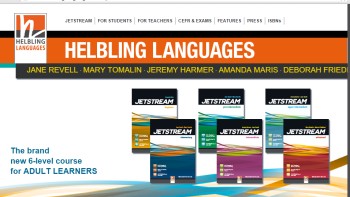
JETSTREAM. Intermediate Student’s Book. J. Harmer and J. Revell. Helbling Languages (2015) ISBN 978-3-85272-984-8 pp. 176. Intermediate Workbook. I. Wisniewska. Helbling Languages (2015) ISBN 978-3-85272-985-5 pp. 95. This is an innovative six level course for adult learners. It aims at preparing learners to use English effectively in their professional and private lives through motivating topics which foster interest and genuine communication. Language practice, especially speaking, involves personalisation, expressing one’s own opinions and ideas. The activities are engaging, especially thanks to dialogue karaoke videos which offer an exciting way to practise real language. Also teaching speaking is strongly connected with teaching good pronunciation. The four language skills: reading, listening, speaking and writing are fully integrated around the given topic of the unit. Extra reading practice comes through lively stories at the end of the book. The authors also include culture, CLIL, critical thinking and memory activities. Vocabulary and grammar are presented and practised in meaningful contexts, with ample practice in the student’s book and workbook. There are additional fully integrated digital components with a lot of opportunities for blended learning. JETSREAM is available on www.helbling-ezone.com
with a cloud version of the book and cyber homework.
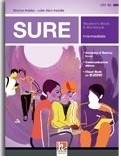
Sure: Student’s Book and Workbook A Intermediate. Martyn Hobbs and Julia Starr Keddie. Helbling Languages (2015) ISBN 978-3-855272-818-4, pp.138.Student’s Book and Workbook B Intermediate. Martyn Hobbs and Julia Starr Keddie. Helbling Languages (2015) ISBN 978-3-855272-836-2, pp 152. This is a brand new and truly innovative four level teenage course ranging from the beginner to intermediate levels. The course addresses contemporary themes and through these topics presents grammar structures and lexis, and teaches the four language skills. The book has a strong focus on accuracy, fluency, communication and natural language. The topics also address cultural issues and CLIL (Content and Language Integrated Learning). The learners develop their learning and study skills, and learner autonomy by using digital resources (each book comes with an access code for online resources – the so called e-zone). The online resources in the Sure Cloud contain an interactive version of the student’s book and workbook, with all the audio and video stories, and an option to take notes. When doing exercises, learners can check their success rate themselves. There are also resources and interactive activities for single student access in the Online Training like Cyber Homework which offers interactive activities assigned by the teacher within the virtual classroom. The Student’s Book and Workbook are one publication, and the course is complete with a teacher’s book, audio CD’s (in British or America English) DVD’s, and a Testbuilder CD-ROM.
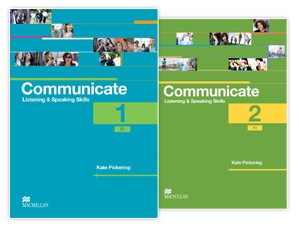
Communicate. Listening and Speaking Skills 1. K. Pickering. Macmillan (this edition 2012) ISBN 978-0-230-44018-0, pp.111. Communicate. Listening and Speaking Skills 2. K. Pickering. Macmillan (this edition 2012) ISBN 978-0-230-44034-0, pp.95. This course aims at developing the learners’ speaking and listening skills through video based activities. It is aimed at young adult learners at B1 level. The course is structured around four areas: personal, social, school and work related situations. The videos introduce and practice various topics like: meeting up, life choices, study abroad, shopping, free time, as well as various cultural aspects of life in the UK. The language input in terms of grammar, lexis and functions is carefully staged; then follows the production stage with focus on fluency and accurate pronunciation. The students engage in pair work, group work and role plays. The publishers state that the course prepares for exams, but it is not clear what exams. Overall the course would be good supplementary material for classes which need additional listening and speaking practice.
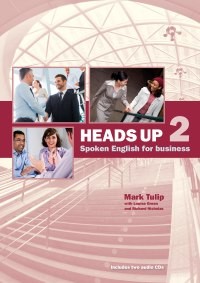
Heads Up 2. Spoken English for Business. Mark Tulip with Louise Green and Richard Nicholas. (2015). ISBN 978-1-905085-97-2, pp 104. The book is part one of a practical two-level course which is aimed at intermediate learners who want to perfect their speaking skills in a professional context at work. It is highly practical, and targets the needs of learners who are under a lot of time pressure and want results fast. The book consists of 40 two page units devoted to topics such as: my CV, my job description, away on business, personal finance, problems and solutions, socialising and phone calls. A typical unit starts with listening tasks which involve listening comprehension as well as observing language in context. Then follows the productive skills stage in the Get ready section: a writing or speaking task; the latter involving mainly pair work. The book is accompanied by two CD’s and can be used for self-study as there is a key and transcripts at the end of the book, although in the case of self-study, pair-work would naturally be impossible.
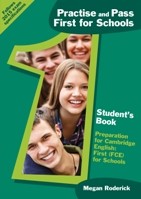
Practise and Pass First for Schools 1. M. Roederick. (2015). ISBN 978-1-909783-08-9, pp 112. The book is part one of a practical two-level course which is aimed at learners who are planning to take the FCE exam, and who want to improve their exam skills. It can be used for intensive exam preparation or alongside a regular course book. The material is based on the updated Cambridge English - First for Schools, 2015 specifications. For this reason the book is divided into four parts: Reading and Use of English, Writing, Listening and Speaking, which reflect the four parts of the exam. Each unit revises and develops some aspect the language needed for good exam performance. Finally there is a practice test which will give the candidates an idea how they might perform in the exam proper. The book is not suitable for self-study as the two audio CD’s, answer keys and tapescripts are included in the teacher’s book.
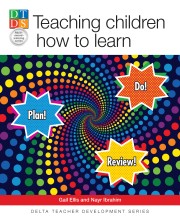
Teaching children how to learn. G. Ellis and N. Ibrahim. DELTA Publishing. (2015). ISBN 978-1-905085-86-6, pp176. This book has been published in the well established DELTA Teacher Development Series. The aim of the book is to give primary teachers a methodology to teach their young learners how to learn. The authors believe that teachers need to create opportunities to help the learners reach their full potential. The authors promote a ‘plan – do – review’ learning cycle. Part A introduces the theory and major concepts regarding learning to learn strategies, explores the nature of language learning when it comes to young learners, and the main pedagogical principles. Part B provides practical activities and ready-to-use materials, divided into three groups: getting started, listen and respond, and read and respond. Part C offers the teachers activities which promote their professional development, help them perfect their teaching strategies, and promotes continuous growth. The teachers can also download templates which facilitate monitoring development and success, activity worksheets, activity record pages and other support material from
www.deltapublishing.co.uk/resources
For sample pages from the book and an interview with one of the authors go to:
www.deltapublishing.co.uk/titles/young-learners/teaching-children-how-to-learn
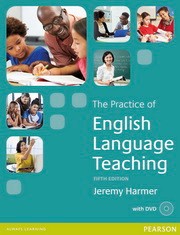
The Practice of English language Teaching. Fifth Edition. J. Harmer. Pearson. (2015). ISBN 978-1-4479-8025-4, pp446. The first edition of the book was published in 1983, the next ones in 1991, 2001 and 2007, and without doubt they have had a great influence on teacher education worldwide. The Practice of English language Teaching is an informative manual for pre-service teachers, and each new edition offers an update on ELT as the book has been revised to reflect new developments in language teaching. The sections in the 5th edition include topics which are also to be found it the previous editions: language systems, popular methodology, being a teacher and a learner, classroom management, teaching grammar and the four language skills, errors and testing, however, I find it hard to judge how and to what extend they have been revised. However, looking at the examples and the bibliography it is clear that they point towards very recent ELT publications. The sections I found interesting are: different Englishes, issues in language teaching and practical implications of research, technology for learning, teaching language construction, although, again, I am not sure if they were included in the 4th edition. The book is very reader friendly, well edited and with ample visual material and tables. It is accompanied by a DVD showing fragments of lessons conducted with learners in different age groups, at different levels and from various countries in the world, as well as conversations about language teaching between the author and the teachers featuring in the video extracts. More components and videos can be found at
www.pearsonelt.com/PracticeofEnglishLanguageTeaching
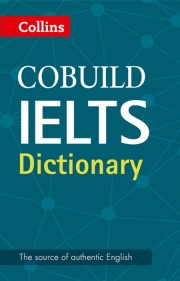
COBUILD IELTS Dictionary. Collins (2015). ISBN 978-0-00-810083-4, pp 962. This is a brand new dictionary for learners preparing for the IELTS exam. It contains all the words and phrases learners need to know to score high in the exam (Band 8/9), but it is useful also for those whose level of English is in the lower bands of the IELTS exam scale. The dictionary is based on the 4.5 billion word Collins language corpus and gives authentic examples to show how the lexis is used in IELTS contexts. The definitions of the words are clear, illustrated with a number of examples; the individual words are often linked to synonyms or near synonyms, for example, the word ‘basis’ is linked to ‘method, system, footing and principle’. Certain lexical key features are highlighted in boxes like: ‘Vocabulary builder’, ‘Word connections’, ‘Word parts’, ‘Usage notes’ and ‘Words in context’. The words that have high frequency in the IELTS exam are highlighted with a special icon. The users of the dictionary get a lot of support on how to use the dictionary thanks to a very informative introduction which contains a guide to the entries, vocabulary features, a list and explanation of grammatical notations, and a guide to the phonemic script to ensure good pronunciation of the individual words. At the end of the dictionary there are two sections which aim at helping the candidates perform better in the written and speaking sections of the IELTS exams.
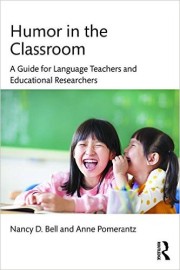
Humour in the Classroom. A Guide for Language Teachers and Educational Researchers. N. D. Bell and A. Pomerantz. Routledge. (2016). ISBN 978-0-415-64054-1, pp201. This book will be of great interest to all those teachers and researchers who are interested in social and cognitive benefits of humour and language play in the classroom. Some might say that humour is the icing on the cake which we can explore once we have dealt with more basic and down to earth aspect of teaching, others will say that it is vital in building relationships, improves classroom discourse, and fosters language development. This is a serious academic book on a seemingly lighthearted subject. It was written by two American scholars, so naturally the book has a US angle, however, most of the points they make apply to the global classrooms. The authors look at a number of areas such as: how humour makes language use more dynamic, different uses of humour, issues related to the use of humour by non-native speakers of the language (additional language users or emergent bilinguals), a review of the still relatively modest body of research, the relationship between learning and humour, conscious use of humour by teachers, and some ideas and guidelines for designing research project. Naturally humour in foreign language classrooms cannot be as free as humour in a class in which the learners use their mother tongue (or their almost mother tongue when they use English as a second language) as a language of instruction, but it is an important aspect of humanising language teaching and EFL teachers can learn a lot from this book.

Please check the Methodology and Language for Primary Teachers course at Pilgrims website.
Please check the Methodology and Language for Secondary Teachers course at Pilgrims website.
Please check the Teaching Advanced Students course at Pilgrims website.
Please check the How to Teach Business Professionals at Pilgrims website.
Please check the English Language Improvement for Teachers course at Pilgrims website.
Please check the English Language Improvement for Adults course at Pilgrims website.
Please check the Creative Methodology for the Classroom course at Pilgrims website.


|